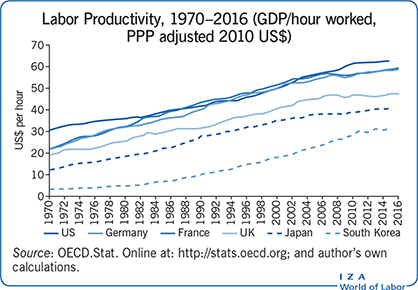Elevator pitch
Aggregate labor productivity is a central indicator of an economy’s economic development and a wellspring of living standards. Somewhat controversially, many macroeconomists see productivity as a primary driver of fluctuations in economic activity along the business cycle. In some countries, the cyclical behavior of labor productivity seems to have changed. In the past 20–30 years, the US has become markedly less procyclical, while the rest of the OECD has not changed or productivity has become even more procyclical. Finding a cogent and coherent explanation of these developments is challenging.

Key findings
Pros
Labor productivity growth is recognized both by growth theory and developmental practice to be associated with high rates of economic growth.
In most OECD economies, aggregate labor productivity also typically moves procyclically.
One explanation of procyclical labor productivity is that business cycles are driven primarily by systematic economy-wide shifts to total factor productivity.
Procyclical productivity can also reflect labor hoarding, and reduction of labor hoarding can lead to more efficiency, lower prices, and better resource allocation.
One contributor to changing cyclical behavior of labor productivity may be the demise of collective bargaining and rising flexibility of labor markets.
Cons
Short-term labor productivity growth is volatile, depends on a host of factors, and is susceptible to significant measurement error.
Notable exceptions to labor productivity moving procyclically include the US and Spain.
Fundamental difficulties involving measurement of total factor productivity growth may lead to incorrect conclusions about its cyclical behavior.
Procyclical labor productivity can also arise from the need to preserve firms’ human capital in temporary economic downturns.
Increased labor productivity may come at a cost of increased unemployment and loss of worker representation at the workplace.